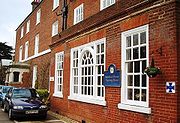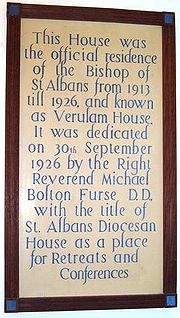
Verulam House, St Albans
Encyclopedia




St Albans
St Albans is a city in southern Hertfordshire, England, around north of central London, which forms the main urban area of the City and District of St Albans. It is a historic market town, and is now a sought-after dormitory town within the London commuter belt...
AL3 4DH on the northwestern side between Church Crescent and Britton Avenue opposite College Street.
It has previously been referred to as Diocesan House
Diocesan House, St Albans
Diocesan House is located in Verulam Road, St Albans on the northern side between Church Crescent and Britton Avenue opposite College Street .It is now known as Verulam House and has also been referred to as the Bishop's Palace....
and also known as the Bishop's Palace.
It is of early nineteenth century origin and is a Grade II Listed Building
Originally built as a coaching inn known as ‘The Verulam Arms’ which opened in 1826 at the same time as Verulam Road which was then a new section of a super highway (post road) built by Thomas Telford
Thomas Telford
Thomas Telford FRS, FRSE was a Scottish civil engineer, architect and stonemason, and a noted road, bridge and canal builder.-Early career:...
(the 'Colossus of Roads') from London to the port of Holyhead
Holyhead
Holyhead is the largest town in the county of Anglesey in the North Wales. It is also a major port adjacent to the Irish Sea serving Ireland....
. The new road bypassed a section of the town and the narrow main road northwest out of St Albans at the time: George Street, Romeland and Fishpool Street. This new inn was reported at the time to be one of the most commodious in Hertfordshire.
In 1848, after the expansion of the railways and the subsequent decline in the stage/mail coach
Mail coach
In Great Britain, the mail coach or post coach was a horse-drawn carriage that carried mail deliveries, from 1784. In Ireland, the first mail coach began service from Dublin in 1789. The coach was drawn by four horses and had seating for four passengers inside. Further passengers were later allowed...
and carriage traffic for which St Albans depended upon for much of its prosperity, the inn was sold and its associated stables were demolished.
The former stable area provided land for the building of an adjacent Roman Catholic church under the patronage of the local MP
Member of Parliament
A Member of Parliament is a representative of the voters to a :parliament. In many countries with bicameral parliaments, the term applies specifically to members of the lower house, as upper houses often have a different title, such as senate, and thus also have different titles for its members,...
of that time, Alexander Raphael
Alexander Raphael
Alexander Raphael was the first British-Armenian to serve in the House of Commons of the United Kingdom. He was returned as a Liberal MP from the Irish constituency of County Carlow, at a by-election in June 1835. However the election was challenged on petition and he was unseated on 19 August 1835...
. Mr Raphael died intestate shortly after commencement of construction of the church and the site was purchased by Mrs Isabella Worley, who had the church completed according to its original design in 1856 and donated it to the Church of England. This church was known as Christ Church and, although it has been converted to offices since the early 1970s, its Lombardic style tower can still be seen on Verulam Road just to the north west of the house.
The house then became a private residence and was occupied in the mid nineteenth century by the Palin family who are believed to have been related to the Vyses (John Palin married Anne Vyse in 1796), operators of a straw hat factory in the Hatfield district of St Albans. This is correct, John Palin married Anne Vyse in 1796.
Between 1913 and 1926 the house was the official residence of the Anglican Bishop of St Albans
Bishop of St Albans
The Bishop of St Albans is the Ordinary of the Church of England Diocese of St Albans in the Province of Canterbury. The bishop is supported in his work by two suffragan bishops, the Bishop of Hertford and the Bishop of Bedford, and three archdeacons....
and was sometimes referred to as the Bishop's Palace.
From 1926 till 1939 and again from 1946 till 1994 it was used as a Diocesan Retreat and Conference Centre by the Church of England
Church of England
The Church of England is the officially established Christian church in England and the Mother Church of the worldwide Anglican Communion. The church considers itself within the tradition of Western Christianity and dates its formal establishment principally to the mission to England by St...
Diocese of St Albans.
Throughout the Second World War it was known as Diocesan House
Diocesan House, St Albans
Diocesan House is located in Verulam Road, St Albans on the northern side between Church Crescent and Britton Avenue opposite College Street .It is now known as Verulam House and has also been referred to as the Bishop's Palace....
. It became a maternity hospital and a facility for training pupil midwives by the General Lying-In Hospital
General Lying-In Hospital
The General Lying-In Hospital was opened in April, 1767, as the Westminster New Lying-in Hospital, on the north side of Westminster Bridge Road Lambeth with Dr. John Leake as its first physician....
which had been evacuated from York Road, Lambeth
York Road, Lambeth
York Road is a road in Lambeth, London running between Westminster Bridge Road and Waterloo Road . To the west is the old County Hall, Shell Centre, Jubilee Gardens and, beyond, the London Eye and the River Thames. Waterloo Station is located on the road's eastern edge, as well as the former...
, (Waterloo), in central London. During the period between September 1939 and June 1946 two thousand babies were born here.
The General Lying-In Hospital was re-established at its former Lambeth
Lambeth
Lambeth is a district of south London, England, and part of the London Borough of Lambeth. It is situated southeast of Charing Cross.-Toponymy:...
premises in 1946 after the end of the war.
In 1994, Verulam House was sold by the Diocese of St Albans and a trust fund set up with the proceeds.
Since 1996 the House has been the site of the 'Verulam House Nursing and Residential Home'.
Verulam House Nursing and Residential Home is owned by Mr Peter Jackson and Dr Damian Tominey and trade as Verulam Healthcare Ltd. www.verulamhouse.co.uk
Verulam House has been extensively extended and refurbished and can accommodate 50 residents for both nursing & residential care. The chapel with all its fine features, is still used today for many activities and dining.
Architectural development
The current complex along the Verulam Road frontage consists of three parts.The first a three-storey building at the Old Church side of the compound is adjoined to a central two-storey structure with a chapel at the rear.
Another two-storey but detached building is located on the eastern side towards what used to be Gombard House.
The exact date of construction, number of rooms and architectural styles of all of these structures have yet to be conclusively ascertained.

